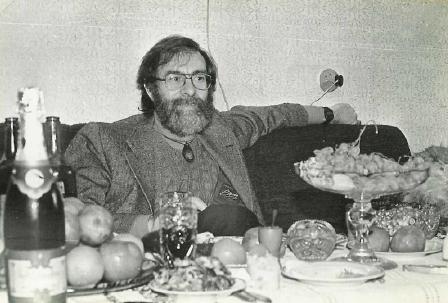Stories
The brain mechanisms of aggression
Motivational systems of social behavior
International Society for Research on Aggression
Behavior Genetics Association Ethics Committee
The World Wide
Runners Club
for Peace
United Nations University for Peace
Charlie Robbins, barefoot runner
* * *
After returning in 1976 from the Soviet Union and finally receiving tenure at Wesleyan, I plunged into scientific research. It was the most fruitful scientific period of my life, as I concentrated my work on developing an analysis of aggressive behavior, including its evolution, brain mechanisms and importance in human behavior. This work included my teaching, laboratory experiments with my students, extensive library research and writing scientific reviews.
Although my priority was research on aggressive behavior, I also undertook other major research projects that turned out to be very fruitful during these years, a project to demonstrate human estrus and a project to explain brain size in animals in terms of metabolism. The latter enabled me to discover a new scientific law, an opportunity that does not come often. Although I did not publish it, I also developed a general model of reproductive systems controlled by hormones acting upon the motivational systems of social behavior.
A high point of each year was the annual meeting of the Neuroscience Society, where 10,000 or more neuroscientists would gather to discuss their work. Like many others, I did not give a formal talk or attend the formal talks of others, but rather spent my time in the rooms with posters, speaking to scientists in front of my own poster, seeking out the posters of others whom I knew or wanted to meet, or just wandering. It was an excellent system for scientific exchange! This was often shared with my Wesleyan colleague Harry Sinnamon or with a new-found friend, Marylou Cheal.
Looking back on the scientific research I was doing in those years, I can think of even more experiments that I did not do than those that I did. That is one of the attractive aspects of scientific research - it's limitless horizons.

Portrait taken of me in 1981 by Misha Nasberg in Soviet Georgia. Click on photo to enlarge.
Beginning around 1978, I began trying to find a way to apply my scientific work to political issues in a direct way. I worked through two scientific organizations, the Behavior Genetics Association and the International Society for Research on Aggression, establishing ethics committees and running a committee of correspondence with society members during the year intervening between society meetings.
In 1979 I began a series of notebooks, paralleling the notebooks for my courses at Wesleyan, on science and politics. I took trips to see two scientists I knew from the earlier days of the Science Action Group at Yale who I knew were grappling with similar concerns: Tom Murphy in Maryland and Henry Lowendorf at Cornell, as well as a physician-scientist doing cancer research and working with the Communist Party in New York. I joined the Benjamin Rush Society in New York and went to some meetings there, again meeting like-minded scientists, and for a time took part in a discussion group with Ethel Tobach.
By 1980 there was a new urgency to my political concerns. My identification of a single gene that was necessary for competitive fighting led to the possibility that the military would use this discovery as the basis for a new and terrible weapon. After that, I lost confidence in the institutions of science and could never again conduct research in the same way as before. Despite, this I maintain to this day my love of the culture of science.
The ISRA work came to full fruition at the international meeting in Holland in August 1980, after which I went to the physiological congress in Budapest. When I returned to the States, Nina said, "I have something important to tell you." Being very tired, I asked if it couldn't wait until morning. "There won't be any morning," she replied. "I've gone to live with someone else." For more on this, see Separation and Divorce
By Christmas of 1980, after one of my periodic breakdowns, I had met Lindsay, and the next year when I went abroad, she took advantage of this to travel for the first time, coming to visit with me in Holland and in Soviet Georgia.
 |
Stages
1986-1992
Fall of Soviet Empire
1992-1997
UNESCO Culture of Peace Programme